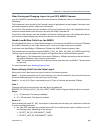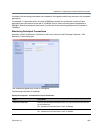
Appendix H - Deployment Into Microsoft Environments
Polycom®, Inc. 999
Video Forcing and Changing Layout in Lync 2013 AVMCU Cascade
Lync 2013 AVMCU Cascade behaves in the same manner as Collaboration Server to Collaboration Server
Cascading.
The Conference Layout as well as the Personal Layouts of participants can be changed. Participants can
be forced to appear in specific video cells of the layouts.
If Lync 2013 video streams are to be included in a Polycom Conference Layout, the Collaboration Server
will remove these streams from the layout sent over the AVMCU cascade link.
If Lync 2013 video streams are to be included in a Personal Conference Layout, the Collaboration Server
will not remove these streams from the layout to be sent over the AVMCU cascade link.
Handle Low Bit Rate Calls From the AVMCU
If the Collaboration Server or a Group Series endpoint is connected to the AVMCU at a bit rate of 256kbps,
the AVMCU transmits only one video stream even if it receives multiple video source requests.
At bit rates lower than256kbps (128kbps and 192kbps) the AVMCU does not transmit video.
This limitation can be controlled using the DISABLE_LYNC_AV_MCU_128_AND_192_KBPS System Flag.
The flag must be manually added to the System Configuration and its value modified as required:
NO (Default)—The Collaboration Server sends 128kbps or 192kbps (according to the call rate) but
will receive 256kbps for each incoming video stream.
YES—The Collaboration Server will not send or receive video from the Lync AVMCU. The connection
is audio only.
For more information see, Modifying System Flags.
Remove Empty Cells From the Video Layout
Empty cells in the Video Layout can occur as result of the following causes:
Case 1 — A camera connected to a PC that is hosting a Lync client is switched off, the cell in which the Lync
client was displayed remains in the video layout and is empty.
Case 2 — A Lync 2013 Client is connected using a CIF port at a bit rate that exceeds 192kbps.
Case 1
The empty cell can be removed from the video layout by adding the
REMOVE_EP_FROM_LAYOUT_ON_NO_VIDEO_TIMER System Flag and setting its value as required.
Range:
● 0 – 19 (seconds): The feature is disabled.
● 20 – 300 (seconds): The feature is enabled.
Default: 20
When enabled (flag value 20 - 300), the endpoint is removed when the empty cell is detected, and the cell
is used for another participant if:
● No video RTP messages are received from the EP for the defined timer value in addition to one of
the following timers, depending on the call type:
DETECT_SIP_EP_DISCONNECT_TIMER
DETECT_H323_EP_DISCONNECT_TIMER


















